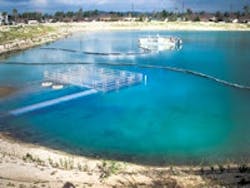About the author: Amy McIntosh is assistant editor for Water & Wastes Digest. McIntosh can be reached at [email protected] or 847.954.7966.
Southern California’s groundwater supply is unpredictable. Because most of the supply to the groundwater basin comes from natural resources, the irregular rainfall in the area can lead to uncertainty about the future of the region’s water supply.
The Orange County Water District (OCWD) in Fountain Valley, Calif., has combated the issue of water scarcity with a 70-million-gal-per-day (mgd) advanced water purification facility, the largest in the U.S.
“Rather than treating wastewater as a waste, we look at it as a resource,” said Michael R. Markus, P.E., general manager of OCWD.
Collaboration & Expansion
In 1976, OCWD built Water Factory 21, a 15-mgd facility that used a reverse osmosis (RO) process to purify wastewater to near-distilled drinking water quality. Water from this facility was injected into a series of injection wells along the coast to prevent seawater from contaminating the area’s groundwater basin.
When the district planned an expansion in the early 1990s, its neighbor, the Orange Country Sanitation District (OCSD), stepped in and proposed the construction of the Groundwater Replenishment System (GWRS).
“At the time, we were looking to expand from 15 mgd, which was the old Water Factory’s capacity, to 35 mgd,” Markus said. “[OCSD] said that if we expanded the project, then they wouldn’t need to build a second ocean outfall.”
By 2004, the districts had secured a $300 million contract to construct a 70-mgd treatment facility. Half of the water is injected into the barrier along the coast, and a $65 million pipeline sends the other 35 mgd to OCWD’s recharge facilities in Anaheim.
The plant uses an advanced purification process to treat the secondary effluent from OCSD. The first step is a microfilitration process, which removes all bacteria, protozoa and suspended solids in the water.
Next, an RO process removes any dissolved minerals, viruses or pharmaceuticals. The final process is an ultraviolet light, followed by addition of hydrogen peroxide to render any remaining contaminants neutral.
OCWD’s permit requires testing for more than 400 compounds, including all 16 pharmaceuticals—all of which are found at non-detectable levels.
The facility went online in January 2008.
Smooth Operations
Any problems that Markus anticipated either before or after the plant went online turned out to be non-issues. The partnership between OCWD and OCSD had the potential to be challenging, but Markus said the two agencies were able to work together to create a successful treatment solution.
“When you have two different agencies [working on these types of projects], there can be a lot of contention between the two,” Markus said. “The way they operate their facility determines the water quality that we get, and they pay careful attention to make sure they’re giving us very good quality secondary effluent.”
Markus cited public perception as another potential problem that the district managed to control through an active outreach program. By educating the public and stakeholders in the project through more than 1,200 presentations in a 10-year period, OCWD has not faced any active opposition to the project.
The SCADA system was another cause for concern for Markus, as the plant was running on new software.
“The process control system really is the key element of a membrane plant because these things have to be just about fully automated to be able to run effectively,” Markus said.
Thanks to in-house programmers, OCWD staff has been able to handle any software upgrades and take care of any problems that arise.
Since the development of the GWRS, OCWD has been less reliant on imported water from Northern California and the Colorado River. Markus also sees the energy savings resulting from recycling effluent as a benefit for the district.
“We can produce the water for about half the energy it takes to bring imported water into Southern California and about a third of what it would take to desalinate seawater,” Markus said. “So there’s tremendous energy efficiency in going to recycled water first.”
The district recently celebrated the fifth anniversary of the GWRS and currently is in the middle of a three-year project that will expand the facility to a capacity of 100 mgd.
“Currently, recycled water accounts for
about 20% of the supply to the groundwater basin; by the time we’ve completed the expansion, it’ll be about a third of the supply,” Markus said. “The project itself is significant in that it’s the largest planned indirect potable reuse project in the world.”
Download: Here
